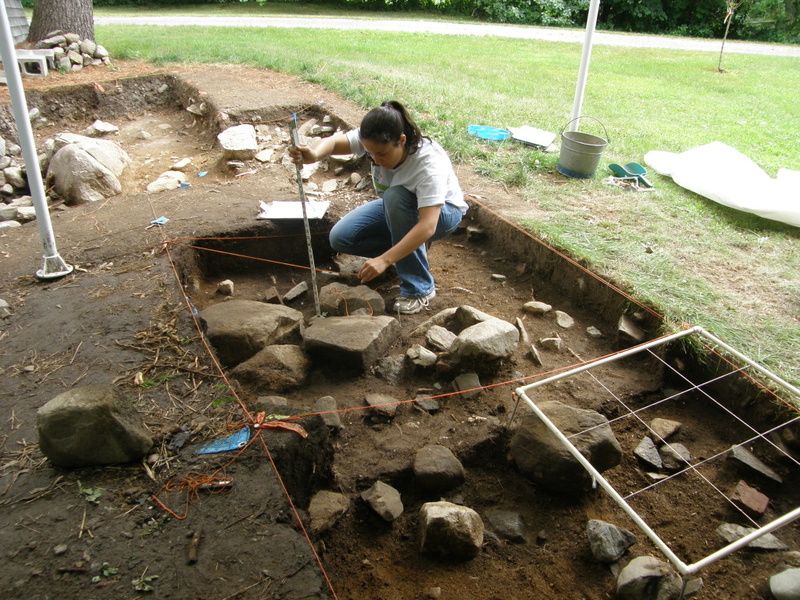Tim Dinsmore spends his days with a mason trowel in hand, scraping away thin layers of soil from small sections of ground, collecting it in a dustpan and processing it through a sifter to ensure no valuable fragments escape his notice.
It is tedious work that Dinsmore, 46, of South Bristol lives for. As a historical archaeologist who focuses on the American Colonial period, he enjoys gathering the archaeological material and available data to offer a snapshot into the lives in the 18th century.
Dinsmore has worked on nearly 50 historic dig sites throughout Maine since 1989, most notably at the homestead sites of 18th-century shipwrights George Barstow and Nathaniel Bryant, who were key in shaping the shipbuilding industry here. Their abutting properties are located along the west bank of the Damariscotta River in Newcastle.
For the past 14 years, Dinsmore has headed digs for the Damariscotta River Association’s Archaeology Field School, educating small crews on the basics of archaeology, including how to excavate, identify and catalog found objects.
Shawn Joy, 32, of Worcester, Mass., will embark on his second summer dig at the site with Dinsmore this July. He is pursuing a major in anthropology with a focus on nautical archaeology.
“As an older college student, seeking a future in this type of work, it was essential to me to be able to get this kind of fieldwork under my belt,” said Joy. “This particular dig is important, as it holds the homesteads of two of the first shipwrights to the Damariscotta region.”
Dinsmore said a complete excavation of the Barstow Homestead site, also called the Hale Site, from 1980 to 2000 yielded more than 100,000 artifacts dating from 1765 to 1785.
“It was an undisturbed site in that no one had built a house near it or dumped anything there since 1785,” said Dinsmore. “To find a site that has not been disturbed like this is pretty rare.”
In 1998, Dinsmore and crews began excavating an abutting property, the Bryant-Barker Tavern Site, occupied by the Bryant family from 1765 to 1803. The homestead was located beneath the well-manicured lawns of two Newcastle homes, whose owners allowed crews to excavate portions of their property each summer, providing they restore the grounds at the end of the season.
Excavation crews are still seeking the location of an east foundation wall and an addition. They also hope to determine whether stones found during a 2008 dig are the remnants of the homestead’s chimney and hearth.
Dinsmore said the process is a lot like detective work, pairing archaeological evidence with historic documents to piece together the puzzle detailing 18th-century life.
Unearthing a priceless object with great historical significance is rare. The more likely finds are obscure fragments of once-whole objects. But those small items, such as straight pins, nails, pottery fragments, beads or musket balls, help tell the bigger story. Copious notes are taken, describing artifacts, where they are found, the soil depth and color; all point to different time periods and origins of their creation and use.
“It’s controlled, slow, painstaking work,” said Dinsmore. “Archaeology is inherently destructive. Once you excavate a site, you can’t put it back. It’s imperative that we take detailed field notes and record our findings. And excavating to find things is only one-third of the job. The remaining time is spent washing, identifying and cataloging items.”
Funding for much of the work comes from the summer field school tuitions, private donation and from grants applied for through the Newcastle Historical Society and the Damariscotta River Association.
Jane Coryell, 73, of Augusta has participated in the weeklong field school sessions for 15 years. She said she enjoys helping Dinsmore put all of the pieces together, helping to process found artifacts off-season.
“This work is interesting and fun,” said Coryell. “Tim is very knowledgeable, and I get to know lots of interesting people.”
Mona Whittaker, 53, a medical transcriber from Nobleboro, has also participated since 1997.
“Archaeology has always been fascinating to me,” said Whittaker. “You are finding articles that link you to the past and bring things that happened 400 years ago to life.”
After all these years, Dinsmore “still loves the thrill of looking for a site and doing careful research.” But he keeps it all in perspective.
“Finding an artifact is neat, but what it tells us about a site and what happened there is what is important,” said Dinsmore. “The great thing about directing the project is that I get to see the big picture, as it develops, over the years.”
Staff Writer Deborah Sayer can be contacted at 791-6308 or at: dsayer@pressherald.com
Send questions/comments to the editors.



Success. Please wait for the page to reload. If the page does not reload within 5 seconds, please refresh the page.
Enter your email and password to access comments.
Hi, to comment on stories you must . This profile is in addition to your subscription and website login.
Already have a commenting profile? .
Invalid username/password.
Please check your email to confirm and complete your registration.
Only subscribers are eligible to post comments. Please subscribe or login first for digital access. Here’s why.
Use the form below to reset your password. When you've submitted your account email, we will send an email with a reset code.